Study on the health impact from beehive coal stoveusage in households in Hoan Kiem, Ha Noi
The combustion of biomass and coal significantly contributes to the total health
burden due to the emission of gaseous pollutants and particulate matter. To determine the
personal exposure related to beehive coal stove cooking in Hanoi, an assessment study on 120
females in three wards (Tran Hung Dao, Phuc Tan, and Chuong Duong) of Ha Noi city, Viet
Nam was conducted. Personal and ambient concentrations of PM2.5 and CO (upwind, nearsource, far-source) were simultaneously measured twice a day at each household by PATS++
equipment developed by Berkeley Air Monitoring group. The concentrations of PM2.5 in the
three wards were in the range of 10-186, 12-441, 9-59, 3-271, and 9-260 µg/m3 while those of
CO varied from 100-3,000, 300-260,000, 200-29,000, 300-255,000, and 2,000-36,000 µg/m3, for
upwind, near-source, far-source, indirect exposure, and direct exposure samples, respectively.
The estimated COHb% for the directly exposed group was higher than the indirectly exposed
group in the three wards. Consequently, the directly exposed group was suffering a higher risk.
All directly exposed respondents and 75 % of indirect ones were experienced COHb%
calculated in blood exceeding the safe threshold for the health of WHO guidelines. There has
been increased risk for both exposed groups if the coal beehive stove placed indoor. The
calculated levels of incremental life cancer risk (ILCR) posed by PM2.5 in the three wards varied
from 1.5E-06 to 3.6E-06 daily, indicating moderate cancer risk to the community that should be
studied further to protect public health.
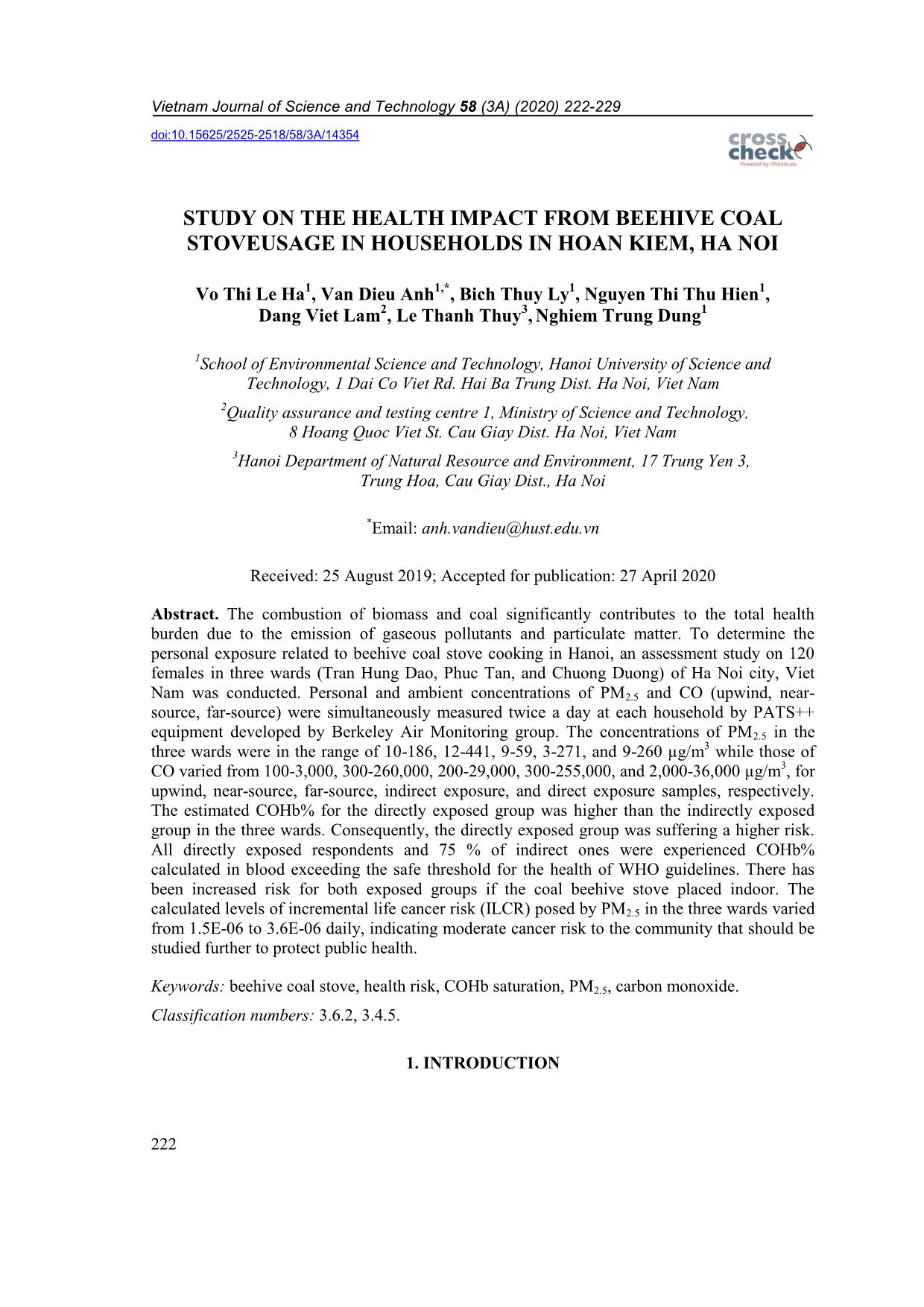
Trang 1
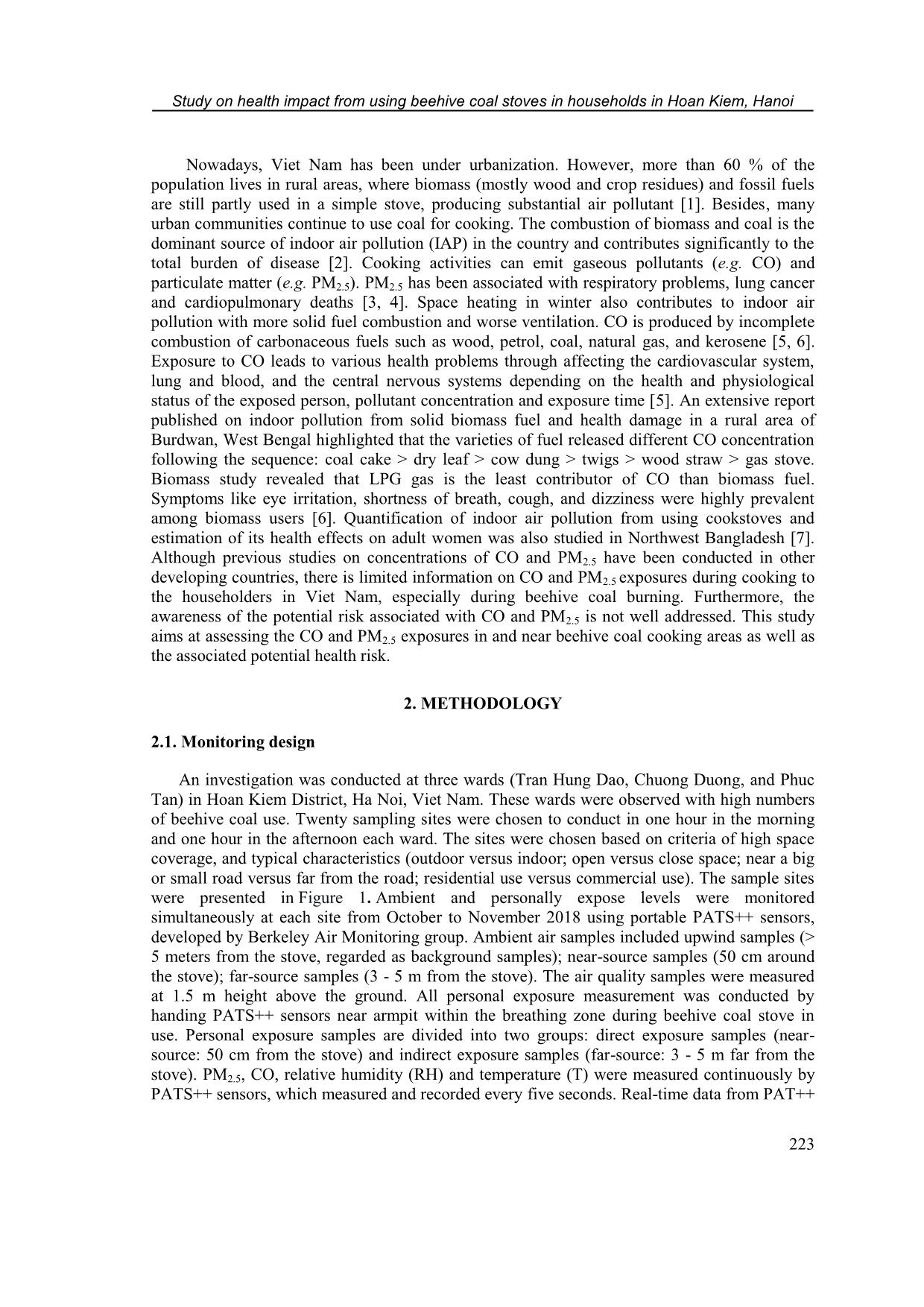
Trang 2
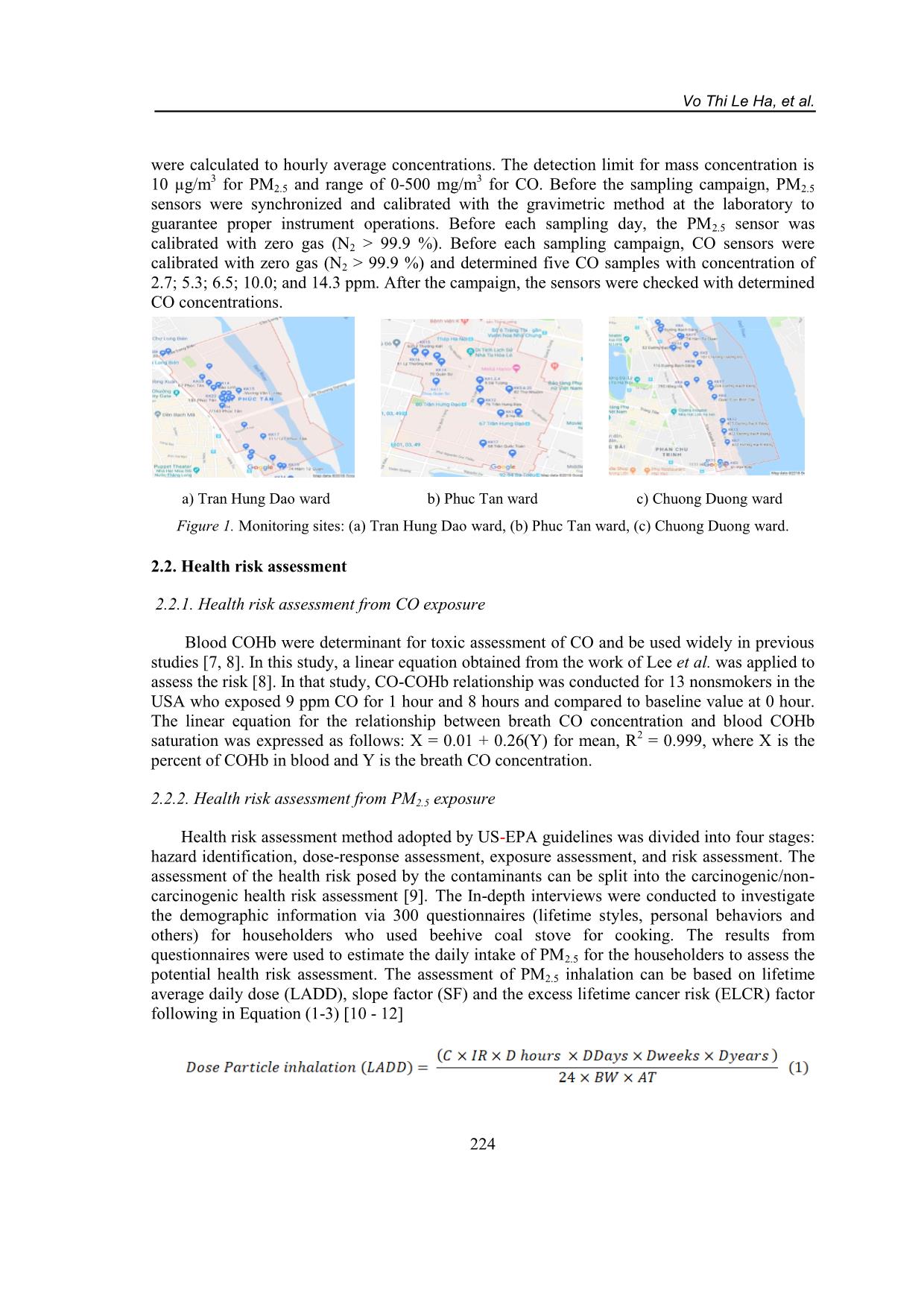
Trang 3
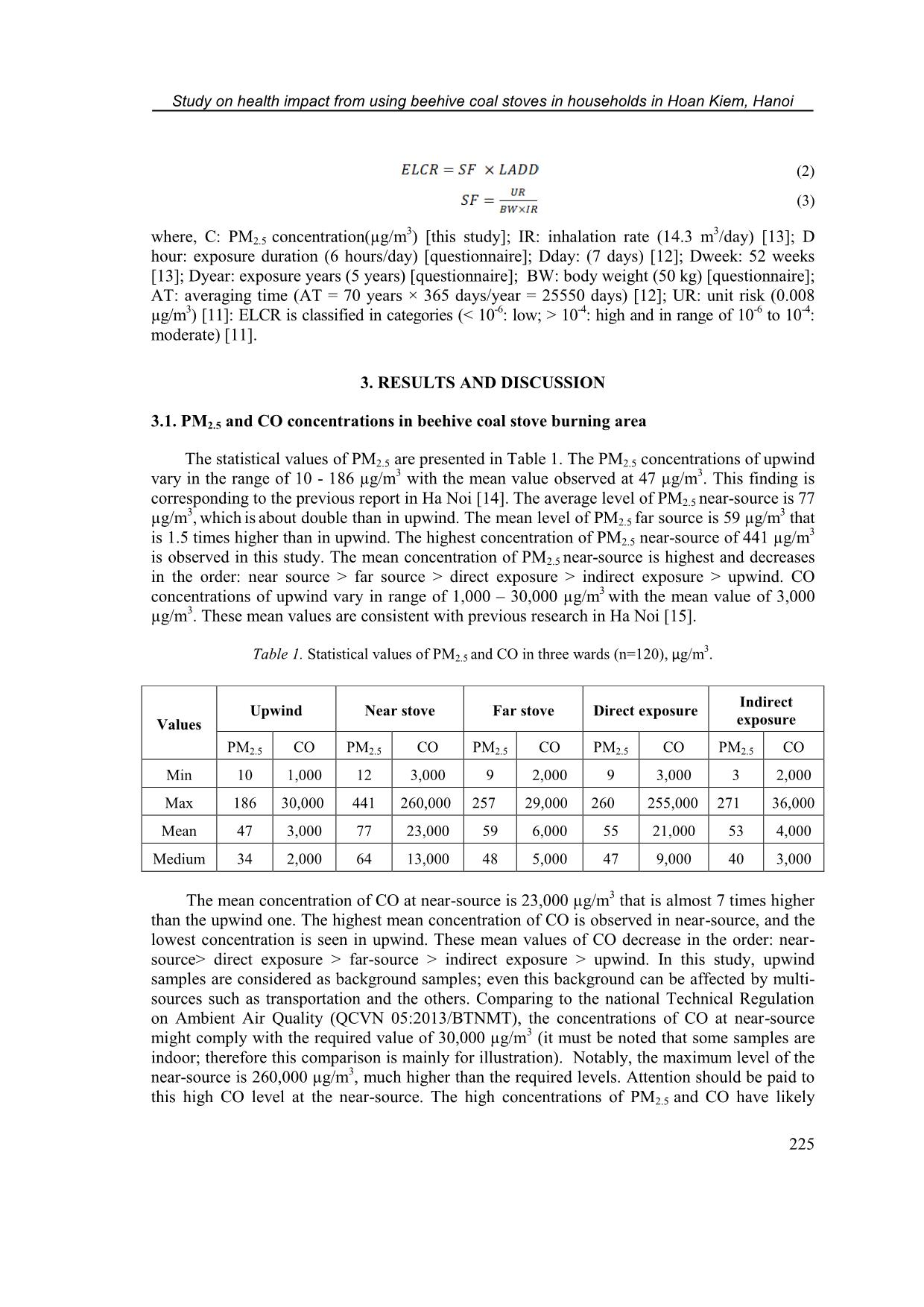
Trang 4
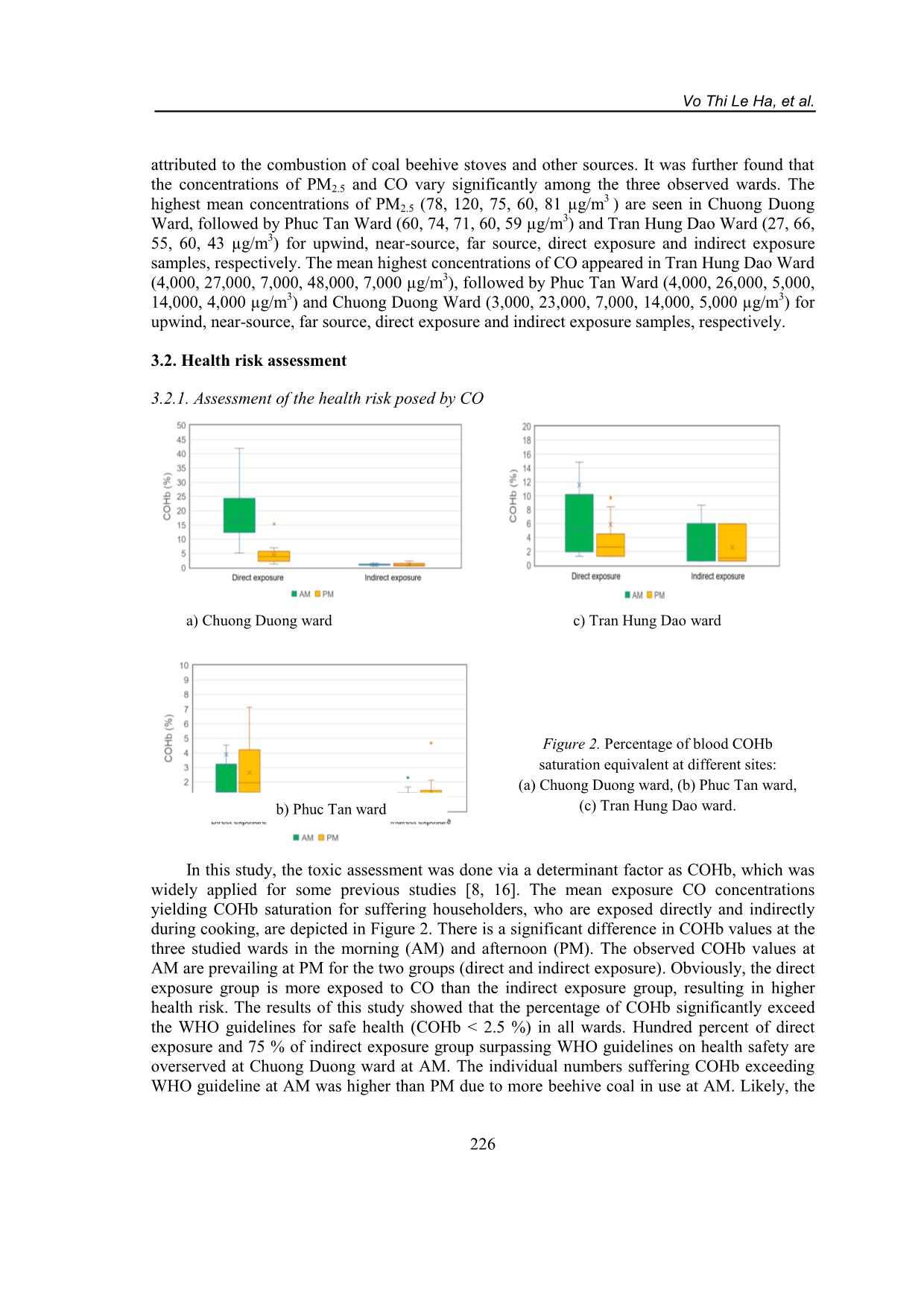
Trang 5
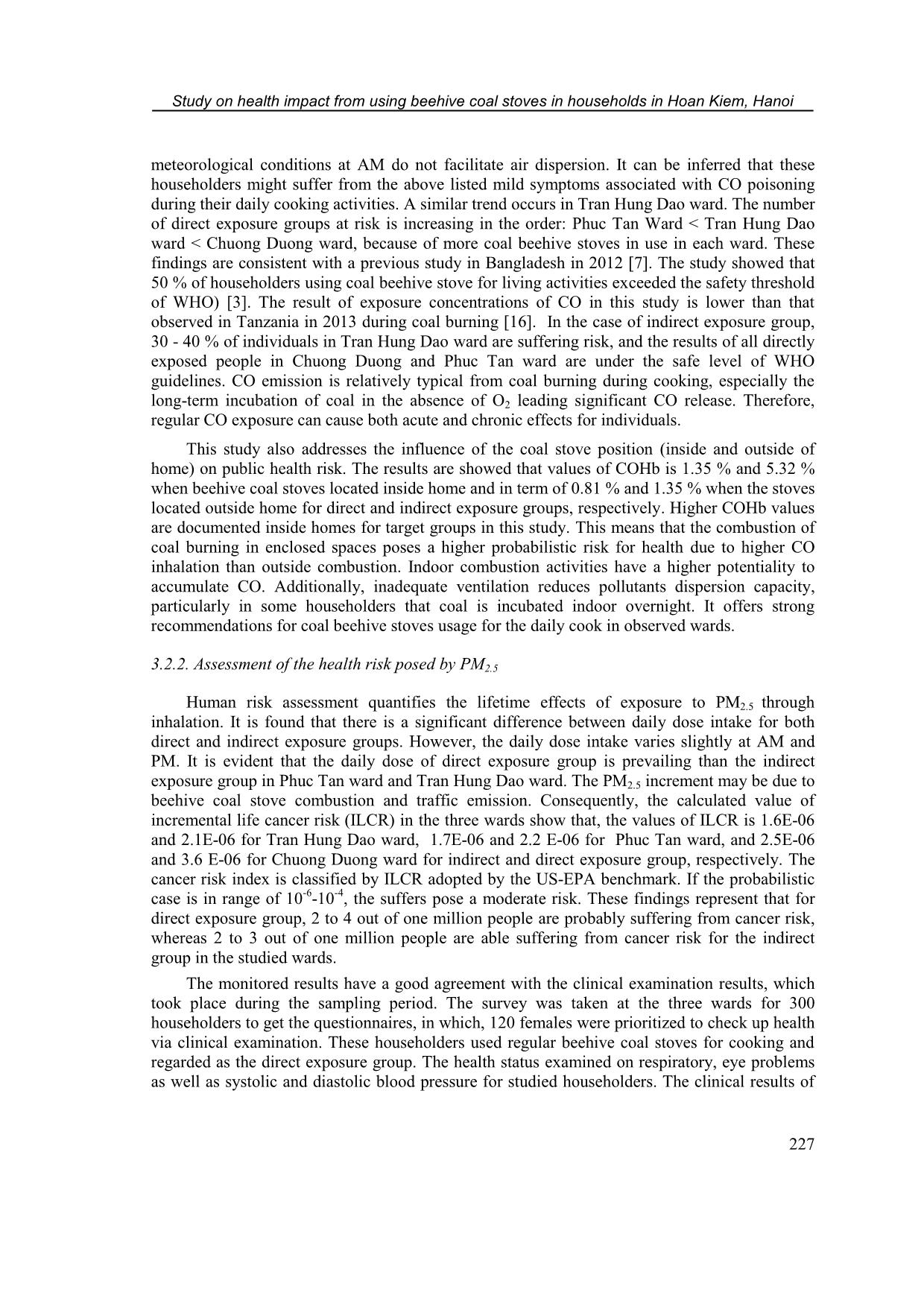
Trang 6
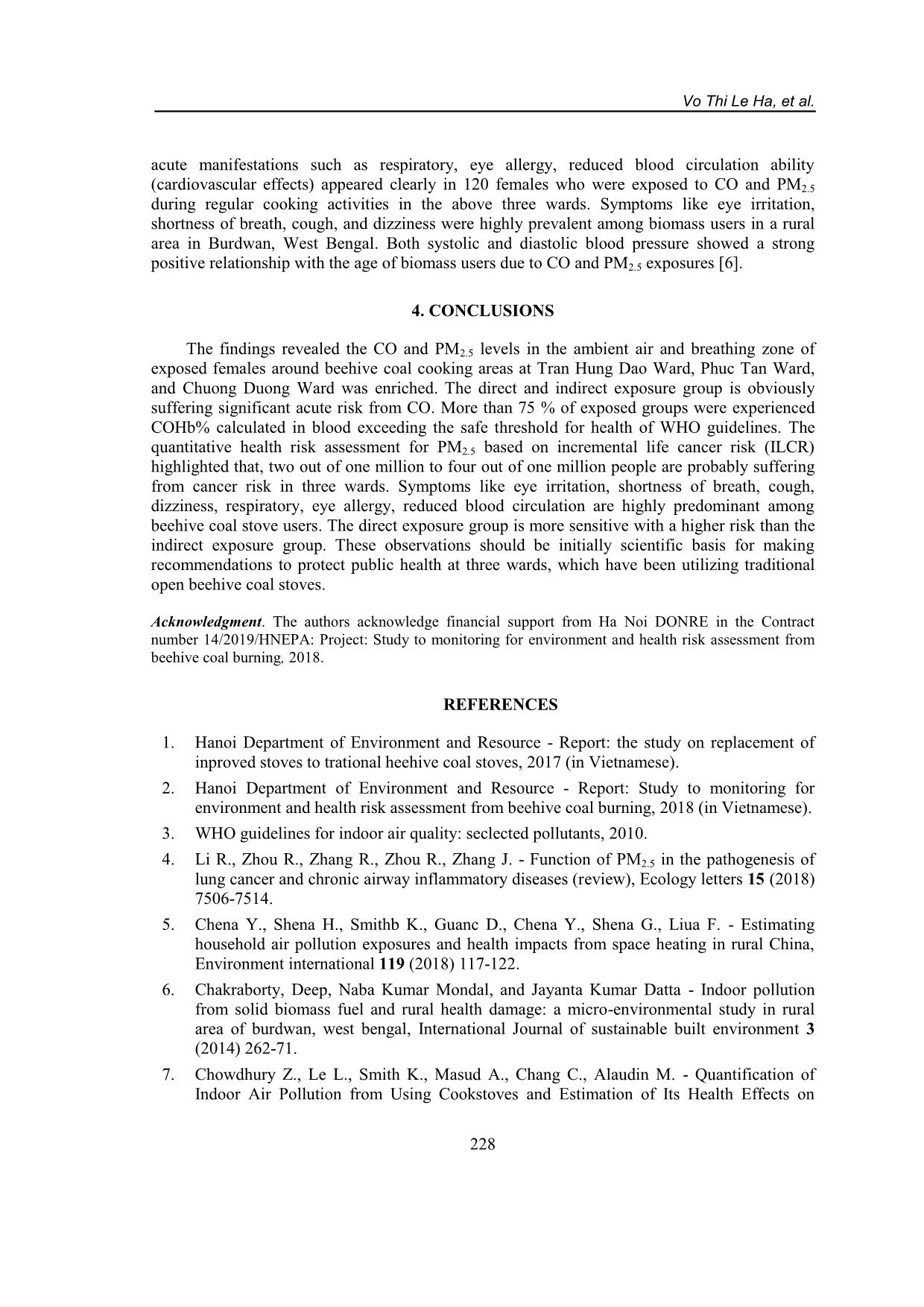
Trang 7
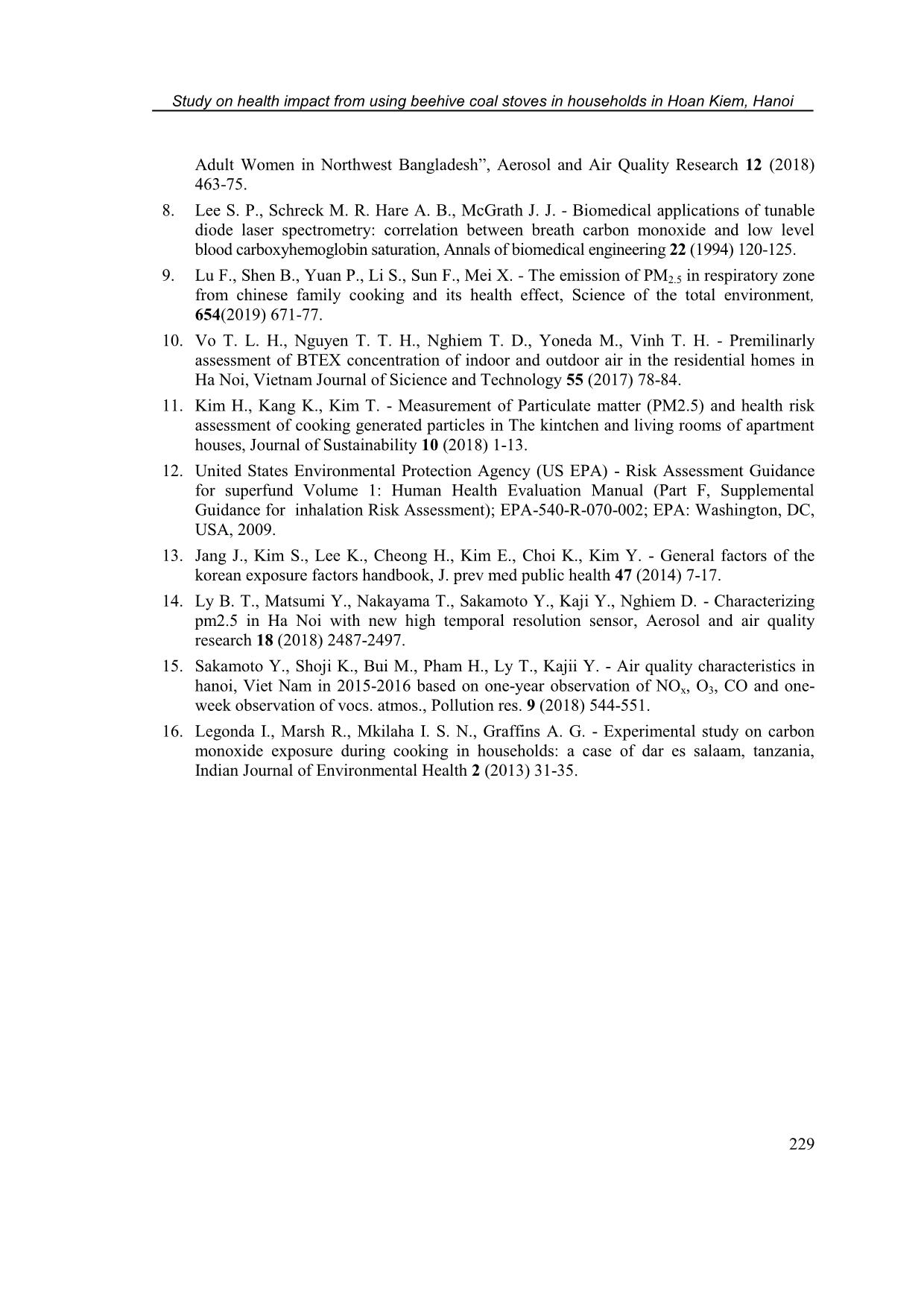
Trang 8
Tóm tắt nội dung tài liệu: Study on the health impact from beehive coal stoveusage in households in Hoan Kiem, Ha Noi
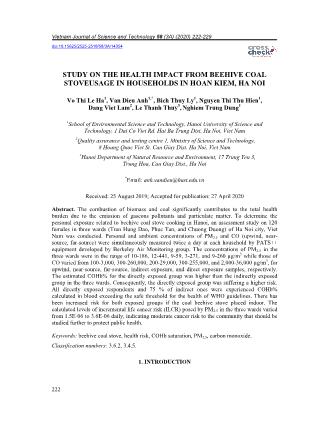
Vietnam Journal of Science and Technology 58 (3A) (2020) 222-229 doi:10.15625/2525-2518/58/3A/14354 222 STUDY ON THE HEALTH IMPACT FROM BEEHIVE COAL STOVEUSAGE IN HOUSEHOLDS IN HOAN KIEM, HA NOI Vo Thi Le Ha 1 , Van Dieu Anh 1,* , Bich Thuy Ly 1 , Nguyen Thi Thu Hien 1 , Dang Viet Lam 2 , Le Thanh Thuy 3 , Nghiem Trung Dung 1 1 School of Environmental Science and Technology, Hanoi University of Science and Technology, 1 Dai Co Viet Rd. Hai Ba Trung Dist. Ha Noi, Viet Nam 2 Quality assurance and testing centre 1, Ministry of Science and Technology, 8 Hoang Quoc Viet St. Cau Giay Dist. Ha Noi, Viet Nam 3 Hanoi Department of Natural Resource and Environment, 17 Trung Yen 3, Trung Hoa, Cau Giay Dist., Ha Noi * Email: anh.vandieu@hust.edu.vn Received: 25 August 2019; Accepted for publication: 27 April 2020 Abstract. The combustion of biomass and coal significantly contributes to the total health burden due to the emission of gaseous pollutants and particulate matter. To determine the personal exposure related to beehive coal stove cooking in Hanoi, an assessment study on 120 females in three wards (Tran Hung Dao, Phuc Tan, and Chuong Duong) of Ha Noi city, Viet Nam was conducted. Personal and ambient concentrations of PM2.5 and CO (upwind, near- source, far-source) were simultaneously measured twice a day at each household by PATS++ equipment developed by Berkeley Air Monitoring group. The concentrations of PM2.5 in the three wards were in the range of 10-186, 12-441, 9-59, 3-271, and 9-260 µg/m 3 while those of CO varied from 100-3,000, 300-260,000, 200-29,000, 300-255,000, and 2,000-36,000 µg/m 3 , for upwind, near-source, far-source, indirect exposure, and direct exposure samples, respectively. The estimated COHb% for the directly exposed group was higher than the indirectly exposed group in the three wards. Consequently, the directly exposed group was suffering a higher risk. All directly exposed respondents and 75 % of indirect ones were experienced COHb% calculated in blood exceeding the safe threshold for the health of WHO guidelines. There has been increased risk for both exposed groups if the coal beehive stove placed indoor. The calculated levels of incremental life cancer risk (ILCR) posed by PM2.5 in the three wards varied from 1.5E-06 to 3.6E-06 daily, indicating moderate cancer risk to the community that should be studied further to protect public health. Keywords: beehive coal stove, health risk, COHb saturation, PM2.5, carbon monoxide. Classification numbers: 3.6.2, 3.4.5. 1. INTRODUCTION Study on health impact from using beehive coal stoves in households in Hoan Kiem, Hanoi 223 Nowadays, Viet Nam has been under urbanization. However, more than 60 % of the population lives in rural areas, where biomass (mostly wood and crop residues) and fossil fuels are still partly used in a simple stove, producing substantial air pollutant [1]. Besides, many urban communities continue to use coal for cooking. The combustion of biomass and coal is the dominant source of indoor air pollution (IAP) in the country and contributes significantly to the total burden of disease [2]. Cooking activities can emit gaseous pollutants (e.g. CO) and particulate matter (e.g. PM2.5). PM2.5 has been associated with respiratory problems, lung cancer and cardiopulmonary deaths [3, 4]. Space heating in winter also contributes to indoor air pollution with more solid fuel combustion and worse ventilation. CO is produced by incomplete combustion of carbonaceous fuels such as wood, petrol, coal, natural gas, and kerosene [5, 6]. Exposure to CO leads to various health problems through affecting the cardiovascular system, lung and blood, and the central nervous systems depending on the health and physiological status of the exposed person, pollutant concentration and exposure time [5]. An extensive report published on indoor pollution from solid biomass fuel and health damage in a rural area of Burdwan, West Bengal highlighted that the varieties of fuel released different CO concentration following the sequence: coal cake > dry leaf > cow dung > twigs > wood straw > gas stove. Biomass study revealed that LPG gas is the least contributor of CO than biomass fuel. Symptoms like eye irritation, shortness of breath, cough, and dizziness were highly prevalent among biomass users [6]. Quantification of indoor air pollution from using cookstoves and estimation of its health effects on adult women was also studied in Northwest Bangladesh [7]. Although previous studies on concentrations of CO and PM2.5 have been conducted in other developing countries, there is limited information on CO and PM2.5 exposures during cooking to the householders in Viet Nam, especially during beehive coal burning. Furthermore, the awareness of the potential risk associated with CO and PM2.5 is not well addressed. This study aims at assessing the CO and PM2.5 exposures in and near beehive coal cooking areas as well as the associated potential health risk. 2. METHODOLOGY 2.1. Monitoring design An investigation was conducted at three wards (Tran Hung Dao, Chuong Duong, and Phuc Tan) in Hoan Kiem District, Ha Noi, Viet Nam. These wards were observed with high numbers of beehive coal use. Twenty sampling sites were chosen to conduct in one hour in the morning and one hour in the afternoon each ward. The sites were chosen based on criteria of high space coverage, and typical characteristics (outdoor versus indoor; open versus close space; near a big or small road versus far from the road; residential use versus commercial use). The sample sites were presented in Figure 1. Ambient and personally expose levels were monitored simultaneously at each site from October to November 2018 using portable PATS++ sensors, developed by Berkeley Air Monitoring group. Ambient air samples ... e of 441 µg/m 3 is observed in this study. The mean concentration of PM2.5 near-source is highest and decreases in the order: near source > far source > direct exposure > indirect exposure > upwind. CO concentrations of upwind vary in range of 1,000 – 30,000 µg/m3 with the mean value of 3,000 µg/m 3 . These mean values are consistent with previous research in Ha Noi [15]. Table 1. Statistical values of PM2.5 and CO in three wards (n=120), µg/m 3 . The mean concentration of CO at near-source is 23,000 µg/m 3 that is almost 7 times higher than the upwind one. The highest mean concentration of CO is observed in near-source, and the lowest concentration is seen in upwind. These mean values of CO decrease in the order: near- source> direct exposure > far-source > indirect exposure > upwind. In this study, upwind samples are considered as background samples; even this background can be affected by multi- sources such as transportation and the others. Comparing to the national Technical Regulation on Ambient Air Quality (QCVN 05:2013/BTNMT), the concentrations of CO at near-source might comply with the required value of 30,000 µg/m 3 (it must be noted that some samples are indoor; therefore this comparison is mainly for illustration). Notably, the maximum level of the near-source is 260,000 µg/m 3 , much higher than the required levels. Attention should be paid to this high CO level at the near-source. The high concentrations of PM2.5 and CO have likely Values Upwind Near stove Far stove Direct exposure Indirect exposure PM2.5 CO PM2.5 CO PM2.5 CO PM2.5 CO PM2.5 CO Min 10 1,000 12 3,000 9 2,000 9 3,000 3 2,000 Max 186 30,000 441 260,000 257 29,000 260 255,000 271 36,000 Mean 47 3,000 77 23,000 59 6,000 55 21,000 53 4,000 Medium 34 2,000 64 13,000 48 5,000 47 9,000 40 3,000 Vo Thi Le Ha, et al. 226 attributed to the combustion of coal beehive stoves and other sources. It was further found that the concentrations of PM2.5 and CO vary significantly among the three observed wards. The highest mean concentrations of PM2.5 (78, 120, 75, 60, 81 µg/m 3 ) are seen in Chuong Duong Ward, followed by Phuc Tan Ward (60, 74, 71, 60, 59 µg/m 3 ) and Tran Hung Dao Ward (27, 66, 55, 60, 43 µg/m 3 ) for upwind, near-source, far source, direct exposure and indirect exposure samples, respectively. The mean highest concentrations of CO appeared in Tran Hung Dao Ward (4,000, 27,000, 7,000, 48,000, 7,000 µg/m 3 ), followed by Phuc Tan Ward (4,000, 26,000, 5,000, 14,000, 4,000 µg/m 3 ) and Chuong Duong Ward (3,000, 23,000, 7,000, 14,000, 5,000 µg/m 3 ) for upwind, near-source, far source, direct exposure and indirect exposure samples, respectively. 3.2. Health risk assessment 3.2.1. Assessment of the health risk posed by CO a) Chuong Duong ward c) Tran Hung Dao ward In this study, the toxic assessment was done via a determinant factor as COHb, which was widely applied for some previous studies [8, 16]. The mean exposure CO concentrations yielding COHb saturation for suffering householders, who are exposed directly and indirectly during cooking, are depicted in Figure 2. There is a significant difference in COHb values at the three studied wards in the morning (AM) and afternoon (PM). The observed COHb values at AM are prevailing at PM for the two groups (direct and indirect exposure). Obviously, the direct exposure group is more exposed to CO than the indirect exposure group, resulting in higher health risk. The results of this study showed that the percentage of COHb significantly exceed the WHO guidelines for safe health (COHb < 2.5 %) in all wards. Hundred percent of direct exposure and 75 % of indirect exposure group surpassing WHO guidelines on health safety are overserved at Chuong Duong ward at AM. The individual numbers suffering COHb exceeding WHO guideline at AM was higher than PM due to more beehive coal in use at AM. Likely, the b) Phuc Tan ward Figure 2. Percentage of blood COHb saturation equivalent at different sites: (a) Chuong Duong ward, (b) Phuc Tan ward, (c) Tran Hung Dao ward. Study on health impact from using beehive coal stoves in households in Hoan Kiem, Hanoi 227 meteorological conditions at AM do not facilitate air dispersion. It can be inferred that these householders might suffer from the above listed mild symptoms associated with CO poisoning during their daily cooking activities. A similar trend occurs in Tran Hung Dao ward. The number of direct exposure groups at risk is increasing in the order: Phuc Tan Ward < Tran Hung Dao ward < Chuong Duong ward, because of more coal beehive stoves in use in each ward. These findings are consistent with a previous study in Bangladesh in 2012 [7]. The study showed that 50 % of householders using coal beehive stove for living activities exceeded the safety threshold of WHO) [3]. The result of exposure concentrations of CO in this study is lower than that observed in Tanzania in 2013 during coal burning [16]. In the case of indirect exposure group, 30 - 40 % of individuals in Tran Hung Dao ward are suffering risk, and the results of all directly exposed people in Chuong Duong and Phuc Tan ward are under the safe level of WHO guidelines. CO emission is relatively typical from coal burning during cooking, especially the long-term incubation of coal in the absence of O2 leading significant CO release. Therefore, regular CO exposure can cause both acute and chronic effects for individuals. This study also addresses the influence of the coal stove position (inside and outside of home) on public health risk. The results are showed that values of COHb is 1.35 % and 5.32 % when beehive coal stoves located inside home and in term of 0.81 % and 1.35 % when the stoves located outside home for direct and indirect exposure groups, respectively. Higher COHb values are documented inside homes for target groups in this study. This means that the combustion of coal burning in enclosed spaces poses a higher probabilistic risk for health due to higher CO inhalation than outside combustion. Indoor combustion activities have a higher potentiality to accumulate CO. Additionally, inadequate ventilation reduces pollutants dispersion capacity, particularly in some householders that coal is incubated indoor overnight. It offers strong recommendations for coal beehive stoves usage for the daily cook in observed wards. 3.2.2. Assessment of the health risk posed by PM2.5 Human risk assessment quantifies the lifetime effects of exposure to PM2.5 through inhalation. It is found that there is a significant difference between daily dose intake for both direct and indirect exposure groups. However, the daily dose intake varies slightly at AM and PM. It is evident that the daily dose of direct exposure group is prevailing than the indirect exposure group in Phuc Tan ward and Tran Hung Dao ward. The PM2.5 increment may be due to beehive coal stove combustion and traffic emission. Consequently, the calculated value of incremental life cancer risk (ILCR) in the three wards show that, the values of ILCR is 1.6E-06 and 2.1E-06 for Tran Hung Dao ward, 1.7E-06 and 2.2 E-06 for Phuc Tan ward, and 2.5E-06 and 3.6 E-06 for Chuong Duong ward for indirect and direct exposure group, respectively. The cancer risk index is classified by ILCR adopted by the US-EPA benchmark. If the probabilistic case is in range of 10 -6 -10 -4 , the suffers pose a moderate risk. These findings represent that for direct exposure group, 2 to 4 out of one million people are probably suffering from cancer risk, whereas 2 to 3 out of one million people are able suffering from cancer risk for the indirect group in the studied wards. The monitored results have a good agreement with the clinical examination results, which took place during the sampling period. The survey was taken at the three wards for 300 householders to get the questionnaires, in which, 120 females were prioritized to check up health via clinical examination. These householders used regular beehive coal stoves for cooking and regarded as the direct exposure group. The health status examined on respiratory, eye problems as well as systolic and diastolic blood pressure for studied householders. The clinical results of Vo Thi Le Ha, et al. 228 acute manifestations such as respiratory, eye allergy, reduced blood circulation ability (cardiovascular effects) appeared clearly in 120 females who were exposed to CO and PM2.5 during regular cooking activities in the above three wards. Symptoms like eye irritation, shortness of breath, cough, and dizziness were highly prevalent among biomass users in a rural area in Burdwan, West Bengal. Both systolic and diastolic blood pressure showed a strong positive relationship with the age of biomass users due to CO and PM2.5 exposures [6]. 4. CONCLUSIONS The findings revealed the CO and PM2.5 levels in the ambient air and breathing zone of exposed females around beehive coal cooking areas at Tran Hung Dao Ward, Phuc Tan Ward, and Chuong Duong Ward was enriched. The direct and indirect exposure group is obviously suffering significant acute risk from CO. More than 75 % of exposed groups were experienced COHb% calculated in blood exceeding the safe threshold for health of WHO guidelines. The quantitative health risk assessment for PM2.5 based on incremental life cancer risk (ILCR) highlighted that, two out of one million to four out of one million people are probably suffering from cancer risk in three wards. Symptoms like eye irritation, shortness of breath, cough, dizziness, respiratory, eye allergy, reduced blood circulation are highly predominant among beehive coal stove users. The direct exposure group is more sensitive with a higher risk than the indirect exposure group. These observations should be initially scientific basis for making recommendations to protect public health at three wards, which have been utilizing traditional open beehive coal stoves. Acknowledgment. The authors acknowledge financial support from Ha Noi DONRE in the Contract number 14/2019/HNEPA: Project: Study to monitoring for environment and health risk assessment from beehive coal burning, 2018. REFERENCES 1. Hanoi Department of Environment and Resource - Report: the study on replacement of inproved stoves to trational heehive coal stoves, 2017 (in Vietnamese). 2. Hanoi Department of Environment and Resource - Report: Study to monitoring for environment and health risk assessment from beehive coal burning, 2018 (in Vietnamese). 3. WHO guidelines for indoor air quality: seclected pollutants, 2010. 4. Li R., Zhou R., Zhang R., Zhou R., Zhang J. - Function of PM2.5 in the pathogenesis of lung cancer and chronic airway inflammatory diseases (review), Ecology letters 15 (2018) 7506-7514. 5. Chena Y., Shena H., Smithb K., Guanc D., Chena Y., Shena G., Liua F. - Estimating household air pollution exposures and health impacts from space heating in rural China, Environment international 119 (2018) 117-122. 6. Chakraborty, Deep, Naba Kumar Mondal, and Jayanta Kumar Datta - Indoor pollution from solid biomass fuel and rural health damage: a micro-environmental study in rural area of burdwan, west bengal, International Journal of sustainable built environment 3 (2014) 262-71. 7. Chowdhury Z., Le L., Smith K., Masud A., Chang C., Alaudin M. - Quantification of Indoor Air Pollution from Using Cookstoves and Estimation of Its Health Effects on Study on health impact from using beehive coal stoves in households in Hoan Kiem, Hanoi 229 Adult Women in Northwest Bangladesh”, Aerosol and Air Quality Research 12 (2018) 463-75. 8. Lee S. P., Schreck M. R. Hare A. B., McGrath J. J. - Biomedical applications of tunable diode laser spectrometry: correlation between breath carbon monoxide and low level blood carboxyhemoglobin saturation, Annals of biomedical engineering 22 (1994) 120-125. 9. Lu F., Shen B., Yuan P., Li S., Sun F., Mei X. - The emission of PM2.5 in respiratory zone from chinese family cooking and its health effect, Science of the total environment, 654(2019) 671-77. 10. Vo T. L. H., Nguyen T. T. H., Nghiem T. D., Yoneda M., Vinh T. H. - Premilinarly assessment of BTEX concentration of indoor and outdoor air in the residential homes in Ha Noi, Vietnam Journal of Sicience and Technology 55 (2017) 78-84. 11. Kim H., Kang K., Kim T. - Measurement of Particulate matter (PM2.5) and health risk assessment of cooking generated particles in The kintchen and living rooms of apartment houses, Journal of Sustainability 10 (2018) 1-13. 12. United States Environmental Protection Agency (US EPA) - Risk Assessment Guidance for superfund Volume 1: Human Health Evaluation Manual (Part F, Supplemental Guidance for inhalation Risk Assessment); EPA-540-R-070-002; EPA: Washington, DC, USA, 2009. 13. Jang J., Kim S., Lee K., Cheong H., Kim E., Choi K., Kim Y. - General factors of the korean exposure factors handbook, J. prev med public health 47 (2014) 7-17. 14. Ly B. T., Matsumi Y., Nakayama T., Sakamoto Y., Kaji Y., Nghiem D. - Characterizing pm2.5 in Ha Noi with new high temporal resolution sensor, Aerosol and air quality research 18 (2018) 2487-2497. 15. Sakamoto Y., Shoji K., Bui M., Pham H., Ly T., Kajii Y. - Air quality characteristics in hanoi, Viet Nam in 2015-2016 based on one-year observation of NOx, O3, CO and one- week observation of vocs. atmos., Pollution res. 9 (2018) 544-551. 16. Legonda I., Marsh R., Mkilaha I. S. N., Graffins A. G. - Experimental study on carbon monoxide exposure during cooking in households: a case of dar es salaam, tanzania, Indian Journal of Environmental Health 2 (2013) 31-35.
File đính kèm:
 study_on_the_health_impact_from_beehive_coal_stoveusage_in_h.pdf
study_on_the_health_impact_from_beehive_coal_stoveusage_in_h.pdf

